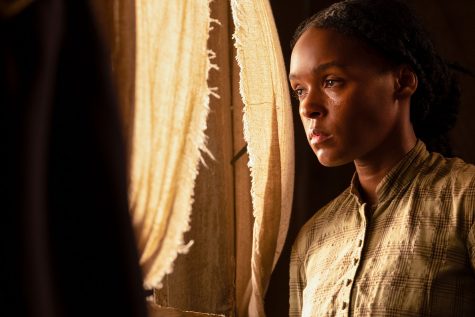Review: ‘Antebellum,’ how ‘show-don’t-tell’ does not work for a movie with lots to say
September 29, 2020

Reality often pales in comparison to the scenarios one makes up in their own head. Watching “Antebellum” felt like when you are in the shower and come up with the perfect comeback you did not have the nerve to say at the time.
“Antebellum” stars entertainer Janelle Monáe as both Eden Henley, an enslaved Black woman in the Confederate South, and Veronica Henley, the present-day version of her character. After Henley bides her time for the right moment to escape, the film attempts a bait-and-switch, much like what happens in “Us” and “Get Out.”
The film opens with a quote by American writer William Faulkner that reads, “The past is never dead. It’s not even past.” This sets the tone for the movie as the two worlds Eden lives in—the time period of enslavement and the 21st century—present a twist that stumbles in its landing.
The twist tries to catapult itself to a level of profoundness befitting a beloved “Twilight Zone” clip. The result, however, is more like a forgotten episode in a meandering season of “Black Mirror,” the sci-fi anthology series on Netflix.
The mind-trick plot is unsurprising though, with directors Gerard Bush and Christopher Renz coming from QC Entertainment, the production company behind “Get Out” and “Us.”
“Antebellum” is a film without much confidence in its audience, as it does not allow viewers to miss a joke or symbol.
It’s impossible to miss that “Becky” joke because the film made sure to hold long shots of name tags to allow a joke to properly land in the following scene—hard.
This is not the only time the film goes out of its way to make sure the audience is picking up what it is putting down. By doing so, it often glosses over important plot points and fails in its attempt to display itself as a profound movie with powerful depictions of slavery and liberation.
Although these examples are a ripple in the overall plot, those ripples turn into crashing waves until the film’s conclusion.
The film also includes juxtaposing scenes that convolute the plot. For example, when Monáe‘s character is fleeing from her enslaver, she passes a present day Civil War reenactment.
By the time the film should have explained why it was important to pass the reenactment and how it relates to the film’s major twist, it makes a mad dash to the next retroactively powerful symbolic shot, therefore, neglecting to tell a cohesive narrative.
While I was occupied with thinking about how the plot could possibly make sense logistically, the film was too focused on the potential of its symbolism to successfully communicate the purpose of the symbolic events within. It is as if the movie were dictated by how it can string together its shots, instead of them being a consequence of the movie’s plot.
The acting could be considered moving and powerful to anyone divorced from the history of enslavement.
As a Black man viewing the film, the acting is more serviceable than great. Its reliance on the anxiety and shock value of Black pain is a tiring experience to sit through because multiple films have depicted enslavement in a similar way.
The film tries too hard to avoid cliché by cavalierly ignoring the conventional narrative of linear storytelling. But this ultimately makes the movie feel incomplete.
The film wants to leave you with the thought-provoking feeling of time being circular. Sadly, the reaction it garnered from me is less of a “wow” and more of an “alright.”
And like the mindset of those who tout the Confederate flag, “Antebellum” is too wrapped up in its own symbolism to deconstruct what it really stands for.







